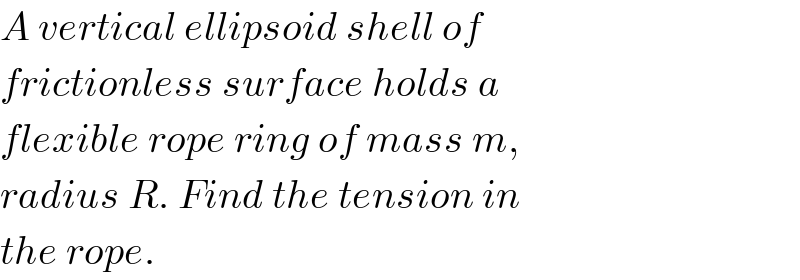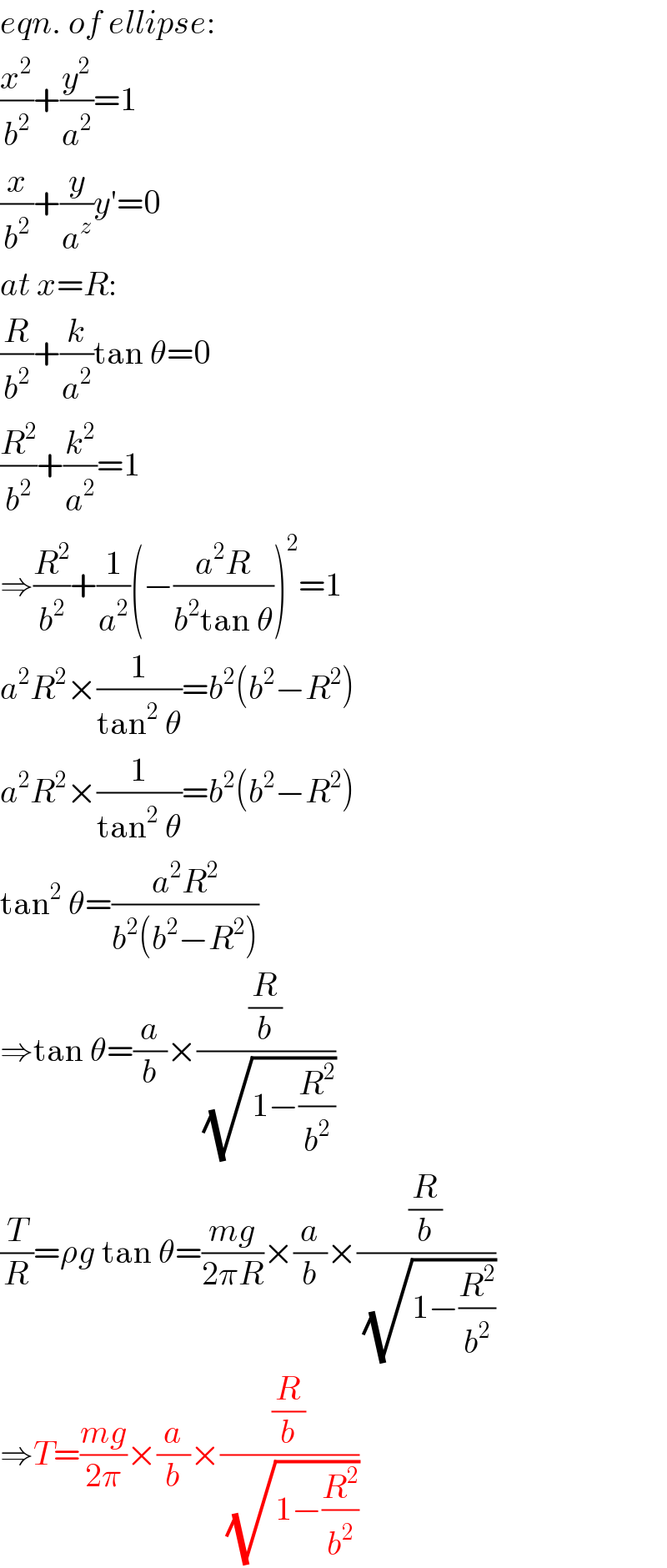
Question Number 47422 by ajfour last updated on 09/Nov/18

Commented by ajfour last updated on 09/Nov/18

$${A}\:{vertical}\:{ellipsoid}\:{shell}\:{of} \\ $$$${frictionless}\:{surface}\:{holds}\:{a} \\ $$$${flexible}\:{rope}\:{ring}\:{of}\:{mass}\:{m}, \\ $$$${radius}\:{R}.\:{Find}\:{the}\:{tension}\:{in}\: \\ $$$${the}\:{rope}. \\ $$
Answered by MrW3 last updated on 09/Nov/18

$${eqn}.\:{of}\:{ellipse}: \\ $$$$\frac{{x}^{\mathrm{2}} }{{b}^{\mathrm{2}} }+\frac{{y}^{\mathrm{2}} }{{a}^{\mathrm{2}} }=\mathrm{1} \\ $$$$\frac{{x}}{{b}^{\mathrm{2}} }+\frac{{y}}{{a}^{{z}} }{y}'=\mathrm{0} \\ $$$${at}\:{x}={R}: \\ $$$$\frac{{R}}{{b}^{\mathrm{2}} }+\frac{{k}}{{a}^{\mathrm{2}} }\mathrm{tan}\:\theta=\mathrm{0} \\ $$$$\frac{{R}^{\mathrm{2}} }{{b}^{\mathrm{2}} }+\frac{{k}^{\mathrm{2}} }{{a}^{\mathrm{2}} }=\mathrm{1} \\ $$$$\Rightarrow\frac{{R}^{\mathrm{2}} }{{b}^{\mathrm{2}} }+\frac{\mathrm{1}}{{a}^{\mathrm{2}} }\left(−\frac{{a}^{\mathrm{2}} {R}}{{b}^{\mathrm{2}} \mathrm{tan}\:\theta}\right)^{\mathrm{2}} =\mathrm{1} \\ $$$${a}^{\mathrm{2}} {R}^{\mathrm{2}} ×\frac{\mathrm{1}}{\mathrm{tan}^{\mathrm{2}} \:\theta}={b}^{\mathrm{2}} \left({b}^{\mathrm{2}} −{R}^{\mathrm{2}} \right) \\ $$$${a}^{\mathrm{2}} {R}^{\mathrm{2}} ×\frac{\mathrm{1}}{\mathrm{tan}^{\mathrm{2}} \:\theta}={b}^{\mathrm{2}} \left({b}^{\mathrm{2}} −{R}^{\mathrm{2}} \right) \\ $$$$\mathrm{tan}^{\mathrm{2}} \:\theta=\frac{{a}^{\mathrm{2}} {R}^{\mathrm{2}} }{{b}^{\mathrm{2}} \left({b}^{\mathrm{2}} −{R}^{\mathrm{2}} \right)} \\ $$$$\Rightarrow\mathrm{tan}\:\theta=\frac{{a}}{{b}}×\frac{\frac{{R}}{{b}}}{\sqrt{\mathrm{1}−\frac{{R}^{\mathrm{2}} }{{b}^{\mathrm{2}} }}} \\ $$$$\frac{{T}}{{R}}=\rho{g}\:\mathrm{tan}\:\theta=\frac{{mg}}{\mathrm{2}\pi{R}}×\frac{{a}}{{b}}×\frac{\frac{{R}}{{b}}}{\sqrt{\mathrm{1}−\frac{{R}^{\mathrm{2}} }{{b}^{\mathrm{2}} }}} \\ $$$$\Rightarrow{T}=\frac{{mg}}{\mathrm{2}\pi}×\frac{{a}}{{b}}×\frac{\frac{{R}}{{b}}}{\sqrt{\mathrm{1}−\frac{{R}^{\mathrm{2}} }{{b}^{\mathrm{2}} }}} \\ $$
Commented by ajfour last updated on 09/Nov/18

$${Thank}\:{you}\:{Sir}. \\ $$
